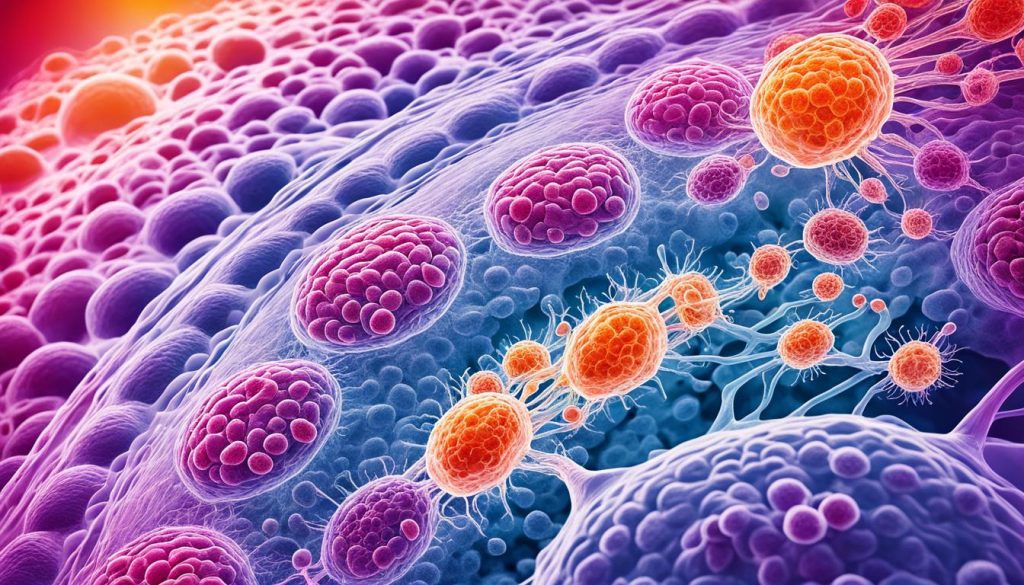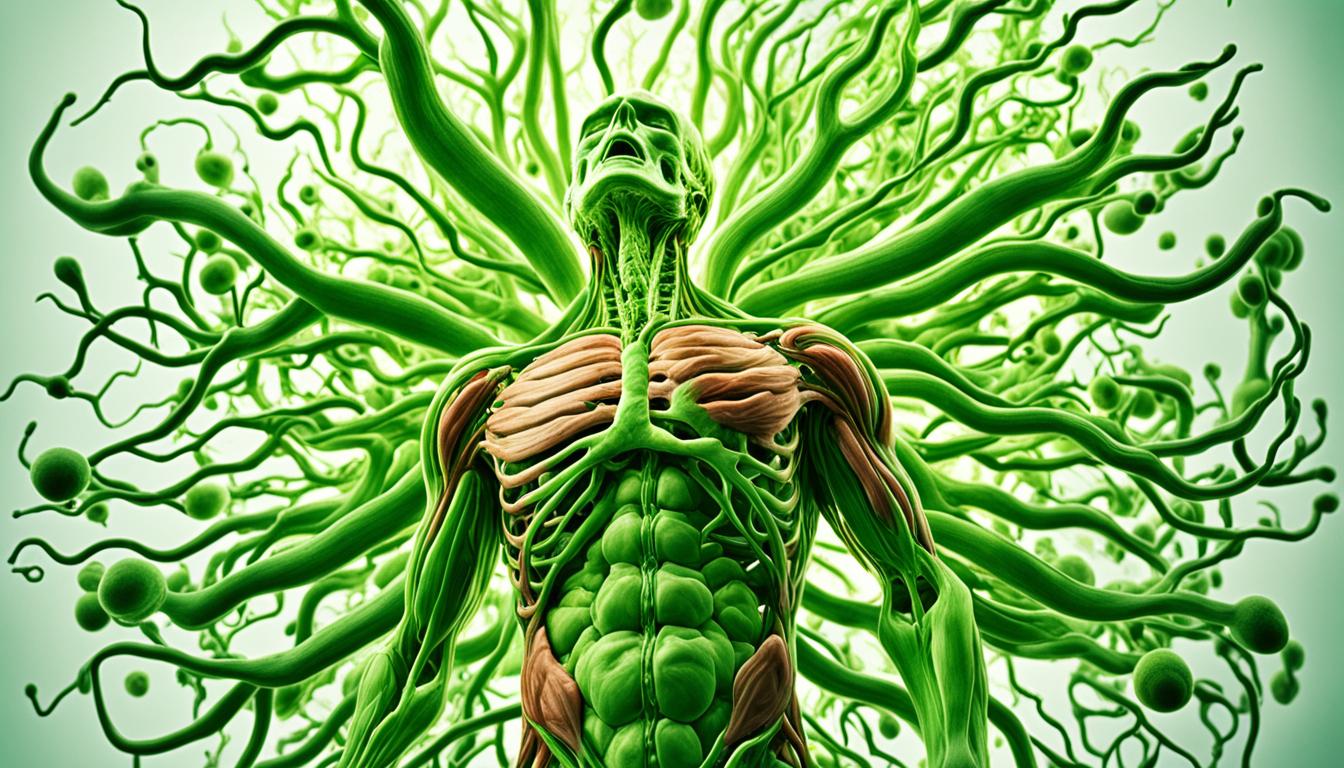Blastocystis hominis is a parasite. It can lead to various symptoms and health issues for people. This article talks about the symptoms, causes, and how it’s diagnosed. It also covers new treatment options, like stem cell therapy.
Key Takeaways:
- Blastocystis hominis is a parasite that can cause gastrointestinal symptoms.
- Common symptoms include diarrhea, abdominal pain, and bloating.
- Poor hygiene and contaminated food or water can contribute to transmission.
- Diagnosis is typically done through stool samples and microscopic examination.
- Researchers are exploring the potential of stem cell therapy as a treatment option.
Symptoms of Blastocystis infection
Getting infected with Blastocystis can cause different symptoms, focusing on your gut. Here are the most common ones:
- Diarrhea: This means having loose, watery poop. You might also feel a need to go more often.
- Abdominal pain: This is when your stomach area hurts or feels cramped.
- Bloating: This is feeling like your belly is swollen or too tight because of gas.
- Excessive gas: This means you might burp or pass gas more than usual.
But, Blastocystis doesn’t just stop at your gut. It can also make you feel:
- Fatigue: You feel very tired all the time and lack energy.
- Nausea: This is when you feel like you might throw up.
- Vomiting: This is actually throwing up.
- Weight loss: You might find you’re losing weight without trying to.
The impact of Blastocystis varies from one person to another. Some might just feel a bit uncomfortable, while others face more severe problems. It’s important to remember that not everyone with the infection shows signs, and some people might carry it without any health issues at all.
Causes of Blastocystis infection
Scientists don’t fully understand why Blastocystis infection happens. But, not washing hands well is a big reason it spreads. If you don’t clean your hands, touching things can pass on the parasite.
Eating or drinking things that have the parasite is another way to get infected. Blastocystis can get into food and water if they touch poop from infected people or animals. This can happen when food is made, or if water is dirty.
Blastocystis can live outside our bodies. It might be in the soil, water, or animal poop. If you swallow something with the parasite, you could get sick.
Transmission of Blastocystis
Blastocystis spreads mainly when poop enters your mouth. This sounds gross but happens more often than we think. It’s why washing hands is so important.
When someone with the parasite doesn’t clean their hands well, they might spread it to others. If they touch something, the next person who touches it might get the parasite.
You can also get Blastocystis by eating contaminated food or water. If cysts are in your drink or food, you could end up with the parasite. This happens if food isn’t cooked right or water is not clean.
Animals can carry Blastocystis too. Being close to infected animals might make you sick. Touching them or their poop raises your infection risk.
To avoid getting Blastocystis, keep your hands clean. Wash them with soap and water often, especially before eating and after the bathroom. Make sure your food and drink are safe by cooking food well and using clean water.
Knowing how Blastocystis spreads helps you stay safe. By taking the right steps, you can keep healthy and avoid this parasite.
Diagnosis of Blastocystis
To diagnose a Blastocystis infection, doctors examine stool samples under a microscope. They look for the parasite. Sometimes, they use special stains to see it better. It’s very important for doctors to tell Blastocystis apart from other tiny organisms in the stool. In some situations, other lab tests are done. These tests confirm Blastocystis or figure out which type it is.
Looking at stool samples under a microscope is key for spotting Blastocystis. When doctors see Blastocystis, they get clues on how to treat the patient. It also helps confirm the person has a Blastocystis infection and not some other issue.
Doctors use their know-how to identify Blastocystis accurately. They look for Blastocystis cysts or trophozoites. Finding these signs means there is an infection. But, doctors need to check many stool samples to be sure. This is because Blastocystis doesn’t always show up in every sample.
Analysing stool samples is critical in dealing with Blastocystis. It helps doctors figure out the treatment and how severe the infection is. As science and technology get better, diagnosing Blastocystis might become faster and more accurate.
Treatment for Blastocystis
Doctors may treat Blastocystis infection differently. This depends on how bad symptoms are and the person’s health. Often, antimicrobial medications like metronidazole or nitazoxanide are used. These drugs kill the organisms causing the infection. This helps get rid of symptoms and clear the infection.
Probiotics, or beneficial bacteria, might also be recommended. Probiotics help balance gut bacteria, which may ease digestive discomfort. They are in some foods or available as supplements. The idea is that a healthier gut can fight off the parasite better.
Making changes to what you eat is also important. Those with Blastocystis should stay away from foods that can make things worse. This includes spicy or greasy foods, processed items, and alcohol. Instead, eating fruits, veggies, whole grains, and lean proteins is encouraged. Drinking plenty of water is also crucial for gut health.
It’s vital for people with this infection to follow their doctor’s advice and finish their treatment. Even if they start feeling better early on. This ensures the parasite is fully gone and lowers the chance of it coming back. Sticking to the treatment plan, like taking medicine as told and changing diet, is crucial for a good outcome.
Treatment for Blastocystis: Overview
| Treatment Options | Description |
|---|---|
| Antimicrobial medications | Prescribed to eliminate the Blastocystis parasite from the body. |
| Probiotics | Beneficial bacteria that help restore the balance of gut microbiota and support gastrointestinal health. |
| Dietary changes | Avoidance of certain foods that may worsen symptoms or trigger inflammation, and consumption of a balanced diet that promotes gut health. |
Blastocystis research
Scientists are diving deep into the study of Blastocystis. They want to understand how common it is, where it’s found, and its effects on our health.
Subtype Distribution
Research has uncovered many Blastocystis subtypes. Each one may affect people differently. Knowing about these subtypes helps us understand the infection better and how severe it can be.
Zoonotic Isolates
Studies have found Blastocystis in animals like mammals and birds. This means it might spread from animals to people. It’s important to learn more about this to find ways to stop it from spreading.
Prevalence Studies
Researchers have looked into how common Blastocystis is in places like Thailand and Saudi Arabia. They’ve been trying to see how many people have it and what makes it spread.
Evaluating the Importance of Blastocystis Research
Keeping up the research is vital. It helps us find better ways to diagnose and treat the infection. By knowing who gets it, how it spreads, and its different types, we can work on stopping it. This effort will help keep people healthier.
Stem cell therapy for Blastocystis
Recently, using stem cell therapy to treat Blastocystis has gained interest. Researchers have looked at hematopoietic stem cell rescue, autologous bone marrow transplantation, and outpatient stem cell transplants for those afflicted. These methods aim to fix the immune system and boost the body’s parasite-fighting powers. Though still under study, early results hint that stem cell therapy could be a hopeful choice for tough Blastocystis cases.

Stem Cell Therapy Approaches
There are different techniques being tested for stem cell therapy on Blastocystis. One involves hematopoietic stem cell rescue. This process transplants healthy stem cells from the patient or a donor. It helps rejuvenate the immune system to better fight the parasite.
Autologous bone marrow transplantation is another strategy. It uses the patient’s own bone marrow, which is collected, processed, and put back into the body. This encourages the growth of healthy immune cells to attack Blastocystis.
Outpatient stem cell transplantation is explored as a less invasive option. Here, stem cells are taken from the patient, enhanced, and infused back in an outpatient setting. It’s designed to assist the immune system in targeting and killing the parasite.
These stem cell treatments seem hopeful. Yet, we need more research to check their effectiveness, safety, and long-term impacts for Blastocystis patients.
Advantages and Challenges
Stem cell therapy could offer benefits over traditional treatments for Blastocystis. It might provide a stronger, more lasting solution by boosting the immune system. Also, it could cut down on the chances of the infection coming back and enhance patient recovery.
But, stem cell therapy’s complexity presents challenges. The treatment needs special medical skills and might not be easy to get everywhere. Plus, possible side effects like graft-versus-host disease or other infections must be thoughtfully managed in those receiving transplants.
Despite these hurdles, ongoing research into stem cell therapy offers hope. It could lead to better treatments for stubborn or severe Blastocystis cases.
| Stem Cell Therapy Approaches | Advantages | Challenges |
|---|---|---|
| Hematopoietic Stem Cell Rescue | – Restores immune system function – Enhances body’s ability to fight off Blastocystis |
– Complex procedure – Availability and accessibility |
| Autologous Bone Marrow Transplantation | – Stimulates production of healthy immune cells – Targeted approach against Blastocystis |
– Potential risks and side effects – Requirement for specialized medical expertise |
| Outpatient Stem Cell Transplantation | – Less invasive procedure – Supports immune system in combating Blastocystis |
– Limited availability in certain regions – Risk management for potential complications |
Conclusion
Blastocystis hominis is a parasite that can cause stomach problems and health issues. It spreads through bad hygiene and eating or drinking something contaminated. Doctors usually find it by checking a stool sample. Treatments include special medications, probiotics, and changing what you eat.
Scientists are also checking out stem cell therapy for the toughest cases of this infection. More research is needed to really understand Blastocystis. We need to know how common it is and how to beat it better. Stem cell treatment could be a new way to help those suffering a lot.
As we learn more about Blastocystis hominis, we’ll find better ways to spot and treat it. By using what we know now and new ideas like stem cell therapy, treatment can get a lot better. This means there’s hope for people dealing with this parasite to have a healthier future.

